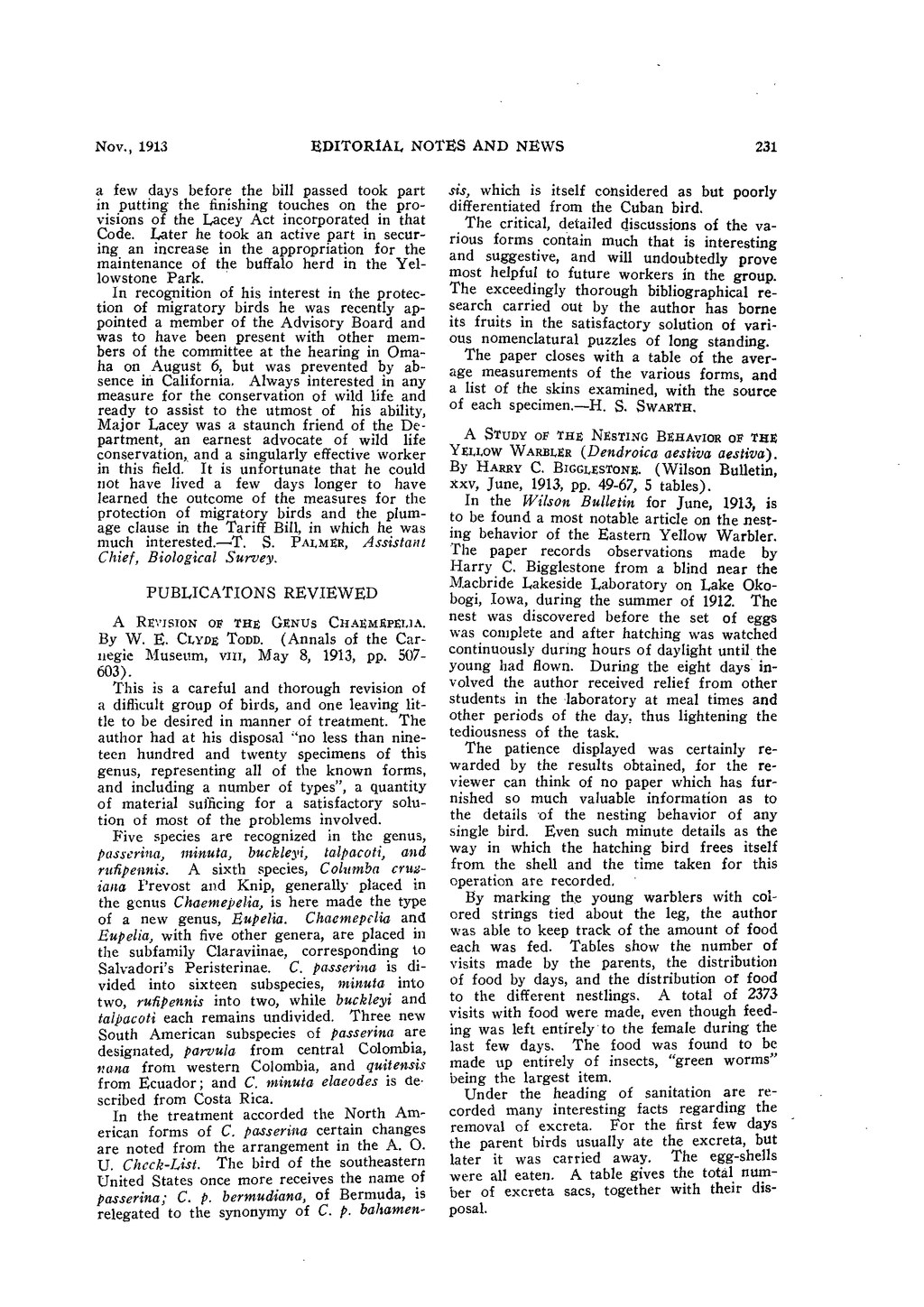Nov., 1913 EDITORIAL NOTES AND NEWS 231 a few days before the bill passed took part in putting the finishing touches on the pro- visions of the Lacey Act incorporated in that Code. Later he took an active part in secur- ing an increase in the appropriation for the maintenance of the buffalo herd in the Yel- lowstone Park. In recognition of his interest in the protec- tion of migratory birds he was recently ap- pointed a member of the Advisory Board and was to have been present with other mem- bers of the committee at the hearing in Oma- ha on August 6, but was prevented by ab- sence in California. Always interested in any measure for the conservation of wild life and ready to assist to the utmost of his ability, Major Lacey was a staunch friend of the De- partment, an earnest advocate of wild life conservation, and a singularly effective worker in this field.' It is unfortunate that he could not have lived a few days longer to have learned the outcome of the measures for the protection of migratory birds and the plum- age clause in the Tariff Bill, in which he was nmch interested.?T. S. P^LM?R, Assistant Chief, Biological Survey. PUBLICATIONS REVIEWED A RE;'ISlON OF THE GENUs C}{AEMI?PELIA. By W. E. CLYDE TODD. (Annals of the Car- negie Museum, v?, May 8, 1913, pp. 507- 6O3). This is a careful and thorough revision of a difl{cult group of birds, and one leaving lit- tle to be desired in manner of treatment. The author had at his disposal "no less than nine- teen hundred and twenty specimens of this genus, representing all of the known forms, and including a number of types", a quantity of material sufficing for a satisfactory solu- tion of most of the problems involved. Five species are recognized in the genus, passerina, minuta, buckleyi, talpacoti, and rut?pennis. A sixth species, Cohtmba cruz- iana }"revost and Knip, generally placed in the genus Chaemepelia, is here made the type of a new genus, Eupelia. Chaemepclia antl Eupelia, with five other genera, are placed in the subfamily Claraviinae, corresponding to Salvadori's Peristerinae. C. passerina is di- vided into sixteen subspecies, minuta into two, rut?pennis into two, while buckleyi and talpacoti each remains undivided. Three new South American subspecies of passerina are designated, parvula from central Colombia, ?.'ana from western Colombia, and quitcrisis from Ecuador; and C. minuta elaeorles is tie- scribed from Costa Rica. In the treatment accorded the North Am- erican forms of C. passerina certain changes are noted from the arrangement in the A. O. U. Check-List. The bird of the southeastern United States once more receives the name of passerina; C. p. bermudiana, of Bermuda, is relegated to the synonymy of C. p. bahamen- sis, which is itself considered as but poorly differentiated from the Cuban bird. The critical, detailed discussions of the va- rious forms contain much that is interesting and suggestive, and will undoubtedly prove most helpful to future workers in the group. The exceedingly thorough bibliographical re- search carried out by the author has borne its fruits in the satisfactory solution of vari- ous nomenclatural puzzles of long standing. The paper closes with a table of the aver- age measurements of the various forms, and a list of the skins examined, with the source of each specimen.--H. S. A STUDY oF YELLow WAP?L? ( Dendroica ae?tiva a?tiva). By HAm? C. Bmo?Eseo?rE. (Wilson Bulletin, xxv, June, 1913, pp. 49-67, 5 tables). In the Wilson Bulletin for June, 1913, is to be found a most notable article on the nest- ing behavior of the Eastern Yellow Warbler. 'The paper records observations made by Harry C. Bigglestone from a blind near the M. acbride Lakeside Laboratory on Lake Oko- bogi, Iowa, during the summer of 1912. The nest was discovered before the set of eggs was complete and after hatching was watched continuously during hours of dayIight until the young bad flown. During the eight days' in- volved the author received relief from other students in the-laboratory at meal times and other periods of the day, thus lightening the tediousness of the task. The patience displayed was certainly re- warded by the results obtained, for the re- viewer can think of no paper which has fur- nished so much valuable information as to the details 'of the nesting behavior of any single bird. Even such minute details as the way in which the hatching bird frees itself from the shell and the time taken for this operation are recorded. By marking the young warblers with col- ored strings tied about the leg, the author was able to keep track of the amount of food each was fed. Tables show the number of visits made by the parents, the distribution of food by days, and the distribution of food to the different nestlings. A total of 2373 visits with food were made, even though feed- ing was left entirely'to the female during the last few days. The food was found to be made up entirely of insects, "green worms" being the largest item. Under the heading of sanitation are re- corded many interesting facts regarding the removal of excreta. For the first few days the parent birds usually ate the excreta, but later it was carried away. The egg-shells were all eaten. A table gives the total num- ber of excreta sacs, together with their dis- posal.
Page:Condor15(6).djvu/43
This page needs to be proofread.
